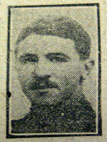 |
Remembrance
- The Yorkshire Regiment, First World War Captain Stanley Burnett KAY Close window to return to main page |
Select the thumbnail image above for a larger photo which opens in a new window.
Captain Stanley Burnett KAY. RFC, ex- 7th
Battalion.
Son of Stanley Robert and Hetty Kay, of High Mead, Wood Lane, Headingley,
Leeds. Killed 28 January 1918. Aged 26.
A Leeds man, Stanley Kay was born in the city in 1892.
He served with the 7th Battalion Yorkshire Regiment, first proceeding to the
front in July 1915. In February 1916 Lt Kay was wounded in action.
On 5 November 1916 Lt Kay was again wounded in action in an attack close to
the village of Le Transloy.
On recovery he was attached to the Royal Flying Corps in 1917 and died at
home on 28 January 28th 1918 aged 26.
He is buried in Leeds (Lawns Wood)
Cemetery.
John Sly (<sly211@btinternet.com>) has written an article on the life and death of Captain Kay. This article was published in the June/July 2014 edition of "Medal News". The article is especially interesting in that the tragic death of Captain Kay has been well researched by John Sly, and makes a thought-provoking story.
Army Medal Office rolls confirm the award of his medals, adding Died 28 January
1918.
On the reverse of the MIC his father’s address is given as High Mead,
Wood Lane, Headingly, Leeds
He was born 23 December 1891 at 28 Norwood Terrace, Headingly, Leeds, the
son of Stanley Robert Kay, a mining engineer, and his wife Hettie (nee Tidswell).
His forenames were originally registered as Frederick William Stanley Burnett,
but these
were changed after registration to Stanley Burnett.
He applied for a temporary commission, from the University of Leeds, 18 August
1914. He was commissioned Second Lieutenant 12 September 1914, Lieutenant
19 November 1914, and Captain 13 March 1915.
He was recorded by Wylly as one of the original officers of 7/Yorkshire Regiment
in November 1914.
He was twice wounded. First, at Dickebusch, 14 February 1916, when a fragment
of shell went through his right lower leg. The battalion war diary recorded:
‘About 5 pm small HE and a few shrapnel began to fall in DICKEBUSCH,
which the leading Coy
was first leaving. Capt S B KAY and 2 Lt L A D DAVID were wounded, neither
seriously.’
According to a letter he sent to the War Office (3 June) he was hospitalised
until 21 March, and was not at that time passed fit for general service.
Second, 5 November 1916, at Le Transloy (according to his own letter to the
War Office), when gunshot wounds broke his right forearm and left leg. The
war diary recorded: ‘During...the shelling of our trenches Capt S B
KAY was wounded...’ He
was in hospital until 21 June 1917, the wound in his arm resulting in the
contraction of the fingers of the right hand, rendering his right hand useless,
and making him unfit for anything other than home service.
He died on 28 January 1918 at 106 Marina, St Leonards-On-Sea, having (according
to his death certificate) ‘accidentally shot himself with a revolver
causing laceration of the brain’. This was the outcome of an inquest
held on 30 January. According to the inquest report he was attached to the
Royal Flying Corps as an instructor in photography.
His obituary in the Green Howards Gazette recorded that he was educated at
Leeds Grammar School, and entered his father’s business as a mining
and civil engineer in Leeds.
In the probate of his will, his estate was valued as £869 6s 2d.
(Refs: WO 339/13061
WO 95/2004
LG 1914 p 7223
Army Lists
General Register Office
The Green Howards In The Great War (Wylly) pp 213, 218, 227-8
GHG vol XXV p 98)
Select the link below to read the article as published in "Medal News".
-----------------> Return to top of the page